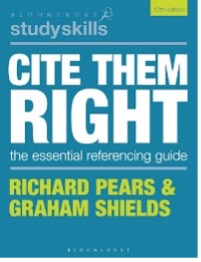

A key practice when it comes to avoiding plagiarism is citing and referencing. Citing your sources is how you give credit to those whose work you are building on and thus avoiding passing the work of other people off as your own.
You must refer to all sources you quote or paraphrase within your document, and this is known as citing. You should always briefly cite the sources you use in your work within the text of your paper as this will refer your reader to your reference list or bibliography where you will provide the extended details of the source.
If you use the words of another author, you must always use quotation marks to indicate that these words are not your own and you must acknowledge the source, including the page number in your brief in-text citation.
If you express another author’s ideas in your own words, this is called paraphrasing and you must still acknowledge the source of the idea.
The Reference list is usually placed at the end of a text (essay or chapter). It contains the list of citations for sources that you have cited within your text.
The Bibliography is placed at the end of your work and comprises the complete list of all references you consulted in preparing the document, whether you cited them in your text or not. It can also include titles useful as background reading.
The basic principles of referencing stay the same no matter what discipline you are writing within -- you must acknowledge your sources. What can and does change is the style of the references (or citations), that is, the way that your sources are presented.
Click the link at left that corresponds to the referencing style that you are using or want to find out more about. Different disciplines use different citation styles and most Schools have a preferred style. Check with your School or consult your course handbook if you aren’t sure which style to use.
| Citing & Referencing | |
 |
Pears, R. and Shields, G. (2022) Cite them right: the essential referencing guide. 12th ed. London: Bloomsbury Publishing. Cite them right provides clear and comprehensive coverage of citing and referencing. This 12th edition continues to provide detailed examples for all print and electronic sources, business, government, technical and legal publications, and works of art and images. This book is available in print and also as an eBook.
|

Here's one definition of academic integrity: It is a commitment, even in the face of adversity, to five fundamental values: honesty, trust, fairness, respect, and responsibility. From these values flow principles of behavior that enable academic communities to translate ideals into action. (Ohio State University 2024).
In other words, you must take full responsibility for your work, acknowledge your own efforts, and acknowledge the contributions of others’ efforts. Working/writing with integrity requires accurately representing what you contributed, as well as acknowledging how others have influenced your work. When you are a student, an accurate representation of your knowledge is important because it will allow both you and your lecturers to know the extent to which you have developed as a scholar. Part of that development is evidenced by how you apply the rules for acknowledging the work of others.
Plagiarism is the act of passing off someone else's work as your own. University of Galway has a plagiarism policy, which includes various penalties for committing plagiarism, depending on severity. You can see these at the following:
University of Galway Academic Integrity
There are a number of ways to actually commit plagiarism, with a range of seriousness. Here is one representation of some of the ways of committing plagiarism from plagiarism detection software company Turnitin:
The Library proactively supports and enhances the learning, teaching, and research activities of the University. The Library acts as a catalyst for your success as University of Galway’s hub for scholarly information discovery, sharing, and publication.
Library
University of Galway
University Road,
Galway, Ireland
T. +353 91 493399